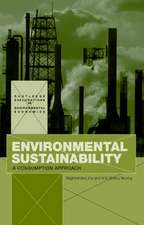Population and Strategies for National Sustainable Development: Health and Population Set
Autor Gayl D. Ness, Meghan V Golayen Limba Engleză Paperback – 26 oct 2016
| Toate formatele și edițiile | Preț | Express |
|---|---|---|
| Paperback (1) | 184.81 lei 6-8 săpt. | |
| Taylor & Francis – 26 oct 2016 | 184.81 lei 6-8 săpt. | |
| Hardback (1) | 496.94 lei 6-8 săpt. | |
| Taylor & Francis – 1997 | 496.94 lei 6-8 săpt. |
Preț: 184.81 lei
Preț vechi: 223.26 lei
-17% Nou
Puncte Express: 277
Preț estimativ în valută:
35.37€ • 36.70$ • 29.56£
35.37€ • 36.70$ • 29.56£
Carte tipărită la comandă
Livrare economică 18 martie-01 aprilie
Preluare comenzi: 021 569.72.76
Specificații
ISBN-13: 9781138979086
ISBN-10: 1138979082
Pagini: 164
Dimensiuni: 174 x 246 mm
Greutate: 0.45 kg
Ediția:1
Editura: Taylor & Francis
Colecția Routledge
Seria Health and Population Set
Locul publicării:Oxford, United Kingdom
ISBN-10: 1138979082
Pagini: 164
Dimensiuni: 174 x 246 mm
Greutate: 0.45 kg
Ediția:1
Editura: Taylor & Francis
Colecția Routledge
Seria Health and Population Set
Locul publicării:Oxford, United Kingdom
Cuprins
Part 1 Introduction; Chapter 1 The Guide: Users, Use, and Basic Orientation; Chapter 2 The Global, Historical Context of Population-Environment Dynamics; Part 2 Population-Environment Linkages in Strategies for National Sustainable Development; Chapter 3 Strategies for Sustainable Development; Chapter 4 The Meaning of Development; Chapter 5 Thinking About Linkages; Chapter 6 Organizing Linkages; Chapter 7 GIS: New Tools for Linking Visual Capacities; Chapter 8 Population-Environment Networks: A Proposed Strategy; Part 3 Linking Population and the Environment – Frameworks and Models; Chapter 9 Introduction; Chapter 10 Characteristics of Frameworks and Models; Chapter 11 Common Frameworks: I=PAT; Chapter 12 Models of Population-Environment Dynamics; Chapter 13 7We shall take some time and space to explore this model for a number of reasons. First is that we find it the most useful and powerful of the models now being used for population environment analyses and planning. In addition, although the model and its full story have been published by Springer-Verlag in Germany in 1994, the price of over US$60 will make it unavailable to many interested readers; Chapter 14 Next Steps; Part 4 Population Parameters and Dynamics; Chapter 15 The Demographic Transitions; Chapter 16 A National Population-Environment Review; Chapter 17 Basic Issues: Size and Vital Rates; Chapter 18 Age/Sex Composition; Chapter 19 Population Momentum; Chapter 20 Migration and Environment; Chapter 21 Urbanization; Chapter 22 Measuring the Quality of Life; Chapter 23 Socially Defined Groups: Gender, Ethnicity and Indigenous Peoples; Chapter 24 Environmental Indicators;


















